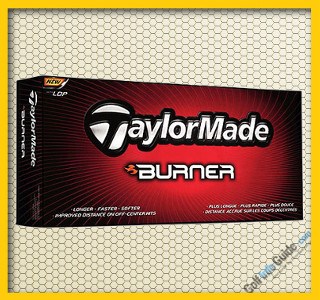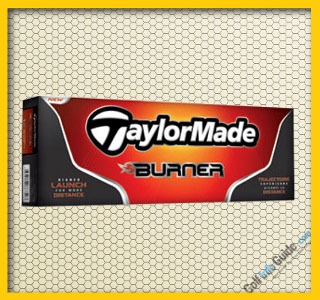
© Taylormade Golf
Ball tested: TaylorMade Burner
Category: Value/Recreational/Distance
Specs: Construction – Two-piece; Cover – Iothane; Core – Polybutadiene; Dimples – 342
Compression: Mid
Price as tested (new): $15.99 per dozen
Ball notes: When it comes to so-called “distance” balls, they don’t make ’em like they used to. And that’s a good thing.
The rock-hard orbs of yore – your Molitors, your Pinnacles, your Top-Flite XLs — have been replaced by a kinder, gentler breed of distance bombs. Lower core compressions and thinner covers have softened these balls considerably without undermining their key function: providing as much distance as possible.
Which brings us to the TaylorMade Burner. While it occupies the bottom rung of the company’s golf ball hierarchy, an overall compression around 75 ensures at least a modicum of “smush” when ball meets clubface. And for a few bucks more, TaylorMade’s SuperDeep distance ball promises even softer feel.
Let’s see how the Burner fared in our tee-to-cup testing.
Sound and feel: The usual caveat applies: All balls are judged against their category competitors, not those with different playing qualities and price points. Thus, the Burner acquits itself quite well for sound and feel vs. its distance counterparts, meaning it’s relatively soft and responsive. Sure, you’ll suffer an unpleasant sensation if you catch an iron shot thin. But solid strikes are rewarded with a good, flush feeling – as they should be.
Off the tee: We really enjoyed seeing the Burner take off high and hang in the air. This is a high-launch, low-spin ball that delivers the kind of length you look for in the distance category. It proved pretty straight, too, and didn’t deviate much in a moderate crosswind.

© Taylormade Golf
From the fairway / rough: While you won’t see a lot of backspin from the Burner, its high trajectory compensates nicely. Short iron shots dropped with a near vertical descent and rolled very little on the green. Low-ball hitters who struggle to stop their approach shots should definitely consider this model.
Around the green: See above… Play the Burner and you won’t wow anyone with hop-and-check action or wickedly spinning sand shots. But if you adjust to playing slightly higher chips and pitches – pretty easy given the ball’s characteristics – you’ll see good results. The ball has a reasonably soft feel on short shots and putts, too.
Bottom line: Let’s make one thing clear: The TaylorMade Burner is designed to maximize distance with the longer clubs. Feel is secondary… But not the afterthought it used to be with value models. This one offers a hint of cushion to complement its excellent performance in the all-important length department. And its high-launch qualities deliver above-average results in the short game.
Golf Ball Videos:
– Compression Video
– Spin Video
– Dimples Video
– Golf Ball Brands Video
– Titleist Video
– Understanding Spin Video
Categories Explained:
Value/Recreational/Distance – Designed for mid- to high-handicap golfers with swing speeds below 90 mph; typically feature two-piece construction and firm covers; promote greater distance over high spin rates. Examples: Pinnacle Gold, Slazenger RAW Distance
Premium – Designed for low- to mid-handicap golfers with swing speeds of 90-99 mph; typically feature multi-layer construction and medium-soft covers; happy medium between Value/Recreational and Tour categories for distance and spin qualities. Examples: Titleist NXT Tour, Callaway HEX Diablo
Tour/Advanced/Performance – Designed for low-handicap and professional golfers with swing speeds in excess of 100 mph; typically feature multi-layer construction and soft covers; promote greater spin rates and enhanced feel over distance. Examples: Titleist ProV1, Bridgestone Tour B330





